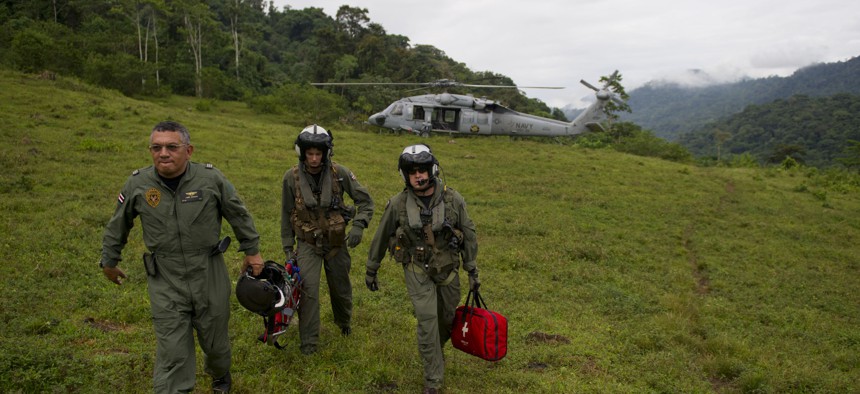
Costa Rica Police Air Patrol Officer Capt. George Lozano, left, Naval Air Crewman 3rd Class Joe Wainscott and Chief Naval Air Crewman Justin Crowe head toward a village to assist an injured boy in Bajo, Blay, Costa Rica, during Continuing Promise 2011. U.S. Navy photo by Mass Communication Specialist 2nd Class Jonathen E. Davis
No One’s Supplanting US Military Influence in Latin America
Concerns about Chinese, Russian, and Iranian forays are overblown.
Many U.S. and Latin American experts who analyze inter-American military relations tend to repeat two inaccuracies. First, they confuse diplomatic statements and military realities. Second, they reckon that the military policies of China, Russia, Iran, and India towards Latin America are generating a disturbing imbalance that is detrimental to Washington.
The former tendency is exemplified by an emphasis on then-Secretary of State John Kerry’s 2013 speech announcing the end of the Monroe Doctrine. In practice, however, the Defense Department and especially U.S. Southern Command, have reaffirmed their supremacy in Latin America.
The latter tendency requires a bit more unpacking. There is no doubt that China’s economic growth is being accompanied by an incipient military projection beyond its regional area of influence, including attempts to boost arms exports to Latin America. Yet Bejing’s effective military impact upon Latin America in the region remains low — with the exception of its arms exports to Venezuela. Russia is the region’s largest foreign arms supplier: since 2013, according to SIPRI, Moscow has supplied 27 percent of the region’s imported weapons, more than the United States (15 percent) and France (10 percent) combined. Meanwhile, military ties between Iran and Latin America annoy Washington, but Tehran lacks the capability to ensure its standing or hinder U.S. preeminence in the region. And as for the limited defense ties between India and Latin America, Indian specialist Sanjay Badri-Maharaj says it is a farce to talk about them.
In short, the U.S. military preponderance in the region persists and it is rock-solid. No extra-regional country, individually or jointly, can challenge U.S. military clout and control in the region. Among its instruments are U.S. Southern Command, located in Miami; the U.S. Navy’s Fourth Fleet, disestablished in 1950 and reassembled in 2008; military bases in Cuba and Honduras; cooperative security locations in El Salvador and Aruba-Curacao; and security assistance organizations in various Latin American countries. And while Beijing has sought to implement security cooperation programs and extend more invitations to military courses in China, its efforts are so far dwarfed by Washington’s: according to the Washington Office on Latin America: 75 out of 107 U.S. global military assistance programs are operating in the region, while the last year alone saw 5,361 Latin American military and security personnel trained in the United States.
China and Russia are trying to increase military-to-military contacts, but the United States has the National Guard’s State Partnership Program by which 17 states, plus Puerto Rico and Washington, D.C., have agreements on security and defense with 23 Latin American countries. Beijing and Moscow has been promising material assistance in the area of defense and security, but it is Washington that earlier this year pledged $436 million in military and police aid, according to data from Security Assistance Monitor (https://securityassistance.org/latin-america-and-caribbean) (This year, the U.S. sold $1.3 billion in arms to Mexico alone.
It is true that Russia has expanded its relationship with Venezuela, to the point that it now undertakes military exercises that seriously concern the United States. However, SouthCom conducts regular, collective joint exercises with countries in Latin America through drills such as Panamax, UNITAS, Tradewinds and New Horizons.
And U.S. special operations there have drifted upward. Since 2006, the slice of U.S. special operators deployed to the region has risen from 3 percent to 4.39 percent, according to researcher Nick Turse. In fiscal 2016, the Special Operations Command South conducted several anti-terrorist maneuvers with specialized regional units in the context of a change of focus from Central America to the Caribbean (especially with the Dominican Republic and Trinidad and Tobago) and a growing emphasis on South America (especially Brazil, Chile and Peru). In 2017, the Army’s Special Forces conducted various exercises with the armed forces of the region: with naval forces from Central America targeting drug interdiction; with Colombian and Peruvian units on matters such as drug-trafficking and terrorism, and with special forces from Chile on urban warfare.
In addition, visits to the region by U.S. military officials are very frequent and in some years they have surpassed trips by diplomats. There are some 1,200 uniformed military and civilians dealing with Latin America in SouthCom, more than the total of officials from various government agencies in Washington. The political influence of the military in inter-American relations is such that before assuming their respective presidencies in Colombia and Paraguay, Ivan Duque and Mario Abdo Benitez, visited SouthCom at Doral Florida.
To sum up, the United States remains undoubtedly, and by far, the primus inter pares on military affairs vis-à-vis Latin America. The acceptance of the idea, both in Latin America and the United States, that military policies by China, Russia, and Iran towards the area are alarming is questionable. The available evidence does not support such fear. U.S. military primacy in the Americas is undeniable.



